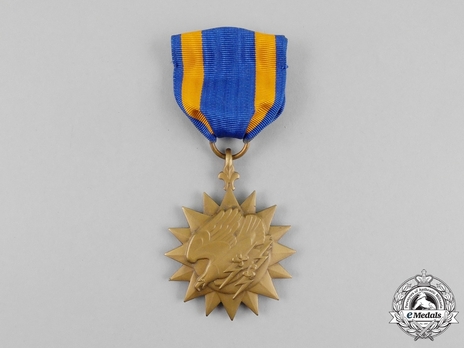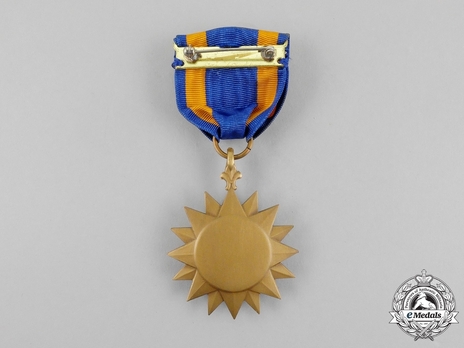Air Medal
SKU: 02.USA.0123.101.01
Estimated market value:


Estimated market value:
Attributes
History
The Air Medal was established by Franklin Roosevelt on May 11, 1942, to protect the prestige of the Distinguished Flying Cross, which was routinely awarded during the Second World War. The Bronze Star is awarded to military, civilian, and foreign personnel who, while serving with the United States Armed Forces as a crew or non-crew member with flying status, have distinguished themselves by single acts of heroism or meritorious achievement, or by meritorious service sustained over a period of 6 months or more, in the performance of normal duties involving regular participation in aerial flight. The distinguished acts must be below that which is required to merit a Distinguished Flying Cross, but which still go beyond the duties normally expected. Certain individuals whose combat duties require regular and frequent flying outside of passenger status or individuals who are crew members without flying status but who have performed a noteworthy act which significantly contributes to operations may also be eligible for the award. The Star is also awarded retroactively until September 8, 1939.
The Star was often awarded upon the completion of a certain number of sorties. Originally, the Star was awarded to the pilot or gunner responsible for the confirmed destruction of 1 naval vessel or 3 enemy aircrafts in flight, for 25 operational flights where an encounter with enemy fire is expected (strikes), or for 10 operational flights where an encounter with enemy fire is not expected (flights). The criteria was later altered by the commanding general of each Air Force to meet the specific conditions of their theatre of operations which would admit the maintenance of morale. Automatic awards of the Air Medal, which were made upon the completion of a set number of operational missions rather than for meritorious service or valour, was not the intention of the award. In 1967 following the Vietnam War (when the practise of awarding automatic Stars became increasingly common), the criteria of the Air Medal for the Army was amended to eliminate qualification based on sorties or hours flown.
The award of the Star is based on different criteria for each department of the Armed Forces, whereby various ribbon device are issued and worn by each department in recognition of different sets of criteria.
The Navy, Marine Corps, and Coast Guard retain the system of awards based on a strike/flight basis. A gold or silver star emblem is worn on the ribbon to denote awards made in recognition of heroism or additional awards. A bronze or gold numeral emblem may be issued to denote awards made on a strike/flight basis. A bronze “V” emblem is also awarded for acts of valour.
Since 1964, the Army has also issued a bronze “V” emblem to denote awards made in recognition of valour. During the Second World War, the Army Air Corps and the United States Army Air Force issued bronze and silver oak leaf clasps to denote additional awards. Currently, Army personnel may be awarded a bronze numeral to denote additional awards.
Members of the Air Force are eligible to wear oak leaf clasps to denote additional awards and a bronze “V” emblem to denote awards made in recognition of valour.
There may be additional clasps or emblems awarded with the Air Medal, but more research is necessary to confirm this. Due to the uncertainty and complexity of the awards system for the ribbon devices, only the Bronze Star without ribbon device is featured here.
It is uncertain if the reverse was officially engraved with the recipient's details. Named and inscribed versions of the Bronze Star may be encountered.


Case Of Issue
$30 USD
Comments
Sign in to comment and reply.


Scroll Top